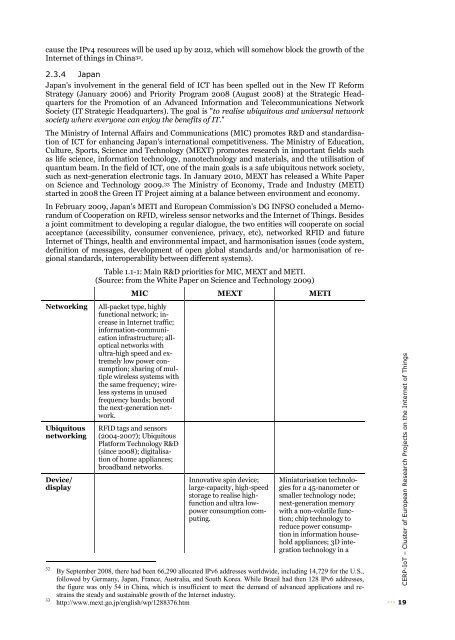Vision and Challenges for Realising the Internet of Things
Vision and Challenges for Realising the Internet of Things
Vision and Challenges for Realising the Internet of Things
You also want an ePaper? Increase the reach of your titles
YUMPU automatically turns print PDFs into web optimized ePapers that Google loves.
cause <strong>the</strong> IPv4 resources will be used up by 2012, which will somehow block <strong>the</strong> growth <strong>of</strong> <strong>the</strong><br />
<strong>Internet</strong> <strong>of</strong> things in China32. 2.3.4 Japan<br />
Japan's involvement in <strong>the</strong> general field <strong>of</strong> ICT has been spelled out in <strong>the</strong> New IT Re<strong>for</strong>m<br />
Strategy (January 2006) <strong>and</strong> Priority Program 2008 (August 2008) at <strong>the</strong> Strategic Headquarters<br />
<strong>for</strong> <strong>the</strong> Promotion <strong>of</strong> an Advanced In<strong>for</strong>mation <strong>and</strong> Telecommunications Network<br />
Society (IT Strategic Headquarters). The goal is "to realise ubiquitous <strong>and</strong> universal network<br />
society where everyone can enjoy <strong>the</strong> benefits <strong>of</strong> IT."<br />
The Ministry <strong>of</strong> Internal Affairs <strong>and</strong> Communications (MIC) promotes R&D <strong>and</strong> st<strong>and</strong>ardisation<br />
<strong>of</strong> ICT <strong>for</strong> enhancing Japan's international competitiveness. The Ministry <strong>of</strong> Education,<br />
Culture, Sports, Science <strong>and</strong> Technology (MEXT) promotes research in important fields such<br />
as life science, in<strong>for</strong>mation technology, nanotechnology <strong>and</strong> materials, <strong>and</strong> <strong>the</strong> utilisation <strong>of</strong><br />
quantum beam. In <strong>the</strong> field <strong>of</strong> ICT, one <strong>of</strong> <strong>the</strong> main goals is a safe ubiquitous network society,<br />
such as next-generation electronic tags. In January 2010, MEXT has released a White Paper<br />
on Science <strong>and</strong> Technology 2009. 33 The Ministry <strong>of</strong> Economy, Trade <strong>and</strong> Industry (METI)<br />
started in 2008 <strong>the</strong> Green IT Project aiming at a balance between environment <strong>and</strong> economy.<br />
In February 2009, Japan's METI <strong>and</strong> European Commission's DG INFSO concluded a Memor<strong>and</strong>um<br />
<strong>of</strong> Cooperation on RFID, wireless sensor networks <strong>and</strong> <strong>the</strong> <strong>Internet</strong> <strong>of</strong> <strong>Things</strong>. Besides<br />
a joint commitment to developing a regular dialogue, <strong>the</strong> two entities will cooperate on social<br />
acceptance (accessibility, consumer convenience, privacy, etc), networked RFID <strong>and</strong> future<br />
<strong>Internet</strong> <strong>of</strong> <strong>Things</strong>, health <strong>and</strong> environmental impact, <strong>and</strong> harmonisation issues (code system,<br />
definition <strong>of</strong> messages, development <strong>of</strong> open global st<strong>and</strong>ards <strong>and</strong>/or harmonisation <strong>of</strong> regional<br />
st<strong>and</strong>ards, interoperability between different systems).<br />
Table 1.1-1: Main R&D priorities <strong>for</strong> MIC, MEXT <strong>and</strong> METI.<br />
(Source: from <strong>the</strong> White Paper on Science <strong>and</strong> Technology 2009)<br />
Networking All-packet type, highly<br />
functional network; increase<br />
in <strong>Internet</strong> traffic;<br />
in<strong>for</strong>mation-communication<br />
infrastructure; alloptical<br />
networks with<br />
ultra-high speed <strong>and</strong> extremely<br />
low power consumption;<br />
sharing <strong>of</strong> multiple<br />
wireless systems with<br />
<strong>the</strong> same frequency; wireless<br />
systems in unused<br />
frequency b<strong>and</strong>s; beyond<br />
<strong>the</strong> next-generation network.<br />
Ubiquitous<br />
networking<br />
Device/<br />
display<br />
MIC MEXT METI<br />
RFID tags <strong>and</strong> sensors<br />
(2004-2007); Ubiquitous<br />
Plat<strong>for</strong>m Technology R&D<br />
(since 2008); digitalisation<br />
<strong>of</strong> home appliances;<br />
broadb<strong>and</strong> networks.<br />
Innovative spin device;<br />
large-capacity, high-speed<br />
storage to realise highfunction<br />
<strong>and</strong> ultra lowpower<br />
consumption computing.<br />
Miniaturisation technologies<br />
<strong>for</strong> a 45-nanometer or<br />
smaller technology node;<br />
next-generation memory<br />
with a non-volatile function;<br />
chip technology to<br />
reduce power consumption<br />
in in<strong>for</strong>mation household<br />
appliances; 3D integration<br />
technology in a<br />
32 By September 2008, <strong>the</strong>re had been 66,290 allocated IPv6 addresses worldwide, including 14,729 <strong>for</strong> <strong>the</strong> U.S.,<br />
followed by Germany, Japan, France, Australia, <strong>and</strong> South Korea. While Brazil had <strong>the</strong>n 128 IPv6 addresses,<br />
<strong>the</strong> figure was only 54 in China, which is insufficient to meet <strong>the</strong> dem<strong>and</strong> <strong>of</strong> advanced applications <strong>and</strong> restrains<br />
<strong>the</strong> steady <strong>and</strong> sustainable growth <strong>of</strong> <strong>the</strong> <strong>Internet</strong> industry.<br />
33 http://www.mext.go.jp/english/wp/1288376.htm<br />
CERP-IoT – Cluster <strong>of</strong> European Research Projects on <strong>the</strong> <strong>Internet</strong> <strong>of</strong> <strong>Things</strong><br />
19
















